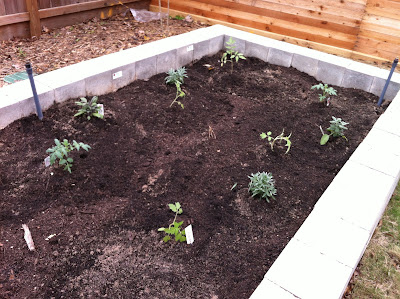Rock, decomposed granite, and turf
Native and drought-tolerant plant species
Vegetable garden
There are a number of strategies for sustainability that manifest themselves through landscape design. For example, by minimizing the percentage of your lot that is covered in conventional turf, you should reduce your water consumption, provided that your irrigation system is well-designed. By minimizing impervious paving (such as concrete driveways, patios, or paths) you assist with both flood prevention - since water gets held in your beds and lawn rather than washing into a storm drain - and reduction of the heat island effect.
LEED for Homes (and common sense) prohibits the introduction of invasive plant species onto the site. It also encourages native and drought tolerant vegetation through points for the number of plants installed that meet those criteria.
There aren't any LEED for Homes points available directly for our raised vegetable and herb garden, but they do afford us the opportunity for some bragging rights. :)








